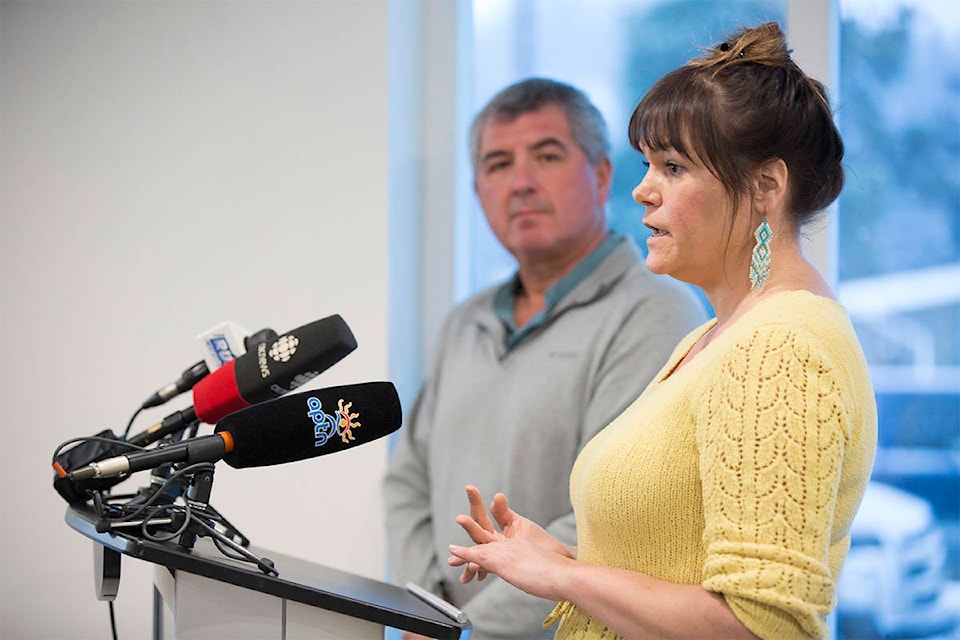The Yukon’s Housing First project is ready to provide permanent housing to those grappling with homelessness.
People will be moved into a new facility located on Wood Street and Fifth Avenue on a staggered basis for the remainder of the month, said Pauline Frost, minister of the Department of Health and Social Services (HSS), on Nov. 12 during an official unveiling of the building.
The move signals an attempt to take pressure off the Whitehorse Emergency Shelter. The number of people going there has swelled since the government took it over from the Salvation Army in January. On any given night, roughly 60 people bed down. When the Salvation Army was in charge, upwards of 15 people stayed there.
There are 16 units in the new building, two of which can accommodate people with mobility issues. These are the biggest, roughly 56 square metres. There could be two to a room in some instances in order to house couples, meaning the number of people who need housing could hit 20. Children aren’t permitted. The remaining units are studio apartments. All are furnished and have kitchens. Staff will help residents cook, clean and complete routine maintenance.
There are no requirements for people wanting to live there, officials said. They don’t need to undergo treatment beforehand or abstain from using substances.
The building is a private residence. This differs from the shelter, which is publicly accessible and provides a consistent complement of services in-house.
The new facility will be staffed by at least one person around the clock, seven days per week.
“The staff will be trained to deescalate difficult situations and will be responsible for monitoring activities in and out of the building,” Frost said. “Staff will also be there to assist residents with daily living activities to provide life skills training and to provide referrals to other services as needed.”
Itinerant supports will be available like nurses and counsellors, said Christine Tapp, director of social supports with HSS, adding that, at this point, they are expected to work part-time hours at the facility.
Questions about whether neighbours have been consulted about the new facility — or, if it has occurred, to what degree — have surfaced during question period at the legislative assembly recently.
“We want to address concerns brought to our attention,” Frost said. “Staff will soon be going door-to-door to connect with neighbours, introduce themselves, answer any questions and explain whom to contact if there are any concerns.
“A callout protocol will also be developed with the RCMP to ensure a timely response to issues as needed.”
Asked by reporters what consultation occurred before the building opened its doors, Lester Balsillie, manager of capital development with Yukon Housing Corporation, said “early discussions” happened with those living around the building, adding that flyers were handed out. There was also an open house.
“I have not received any calls from neighbours in the last little while leading up to this,” he said.
What criteria, if any, potential residents would face in order to secure housing at the facility has been asked of Frost previously. Officials have floated something called a “by name list” for weeks.
Kate Mechan, implementation manager at Safe At Home, said this term means assigning a number that corresponds to someone’s circumstance.
“That number becomes your baseline number for how vulnerable a person is, and that is one factor that can help you place somebody off of the by name list,” she said. “The higher the number, this is where this notion of ‘acuity’ comes in.”
People who appear on the list may suffer from chronic homelessness — defined as 180 days or more without a home — and mental health or substance use issues, among other things.
“So, it is up to a community of social support providers — NGOs and government working together — to figure out who has been the most underserved for the longest, who is the sickest, who is the most in need of support now.”
Mechan clarified that just because someone is considered a high-acuity client doesn’t mean the units fit their needs.
“Perhaps they don’t do well in a community setting,” she said.
There are more people in vulnerable situations than the shelter and Housing First facility can house, she said.
The shelter now provides 20 permanent units.
“This is not the magic bullet that’s gonna end homelessness for us. We know that not everyone can be housed in these 16 units. Those are hard conversations. All the more reason to have a by name list to ensure as units become available … we can offer the next unit to the priority person on that list.”
Contact Julien Gignac at julien.gignac@yukon-news.com
